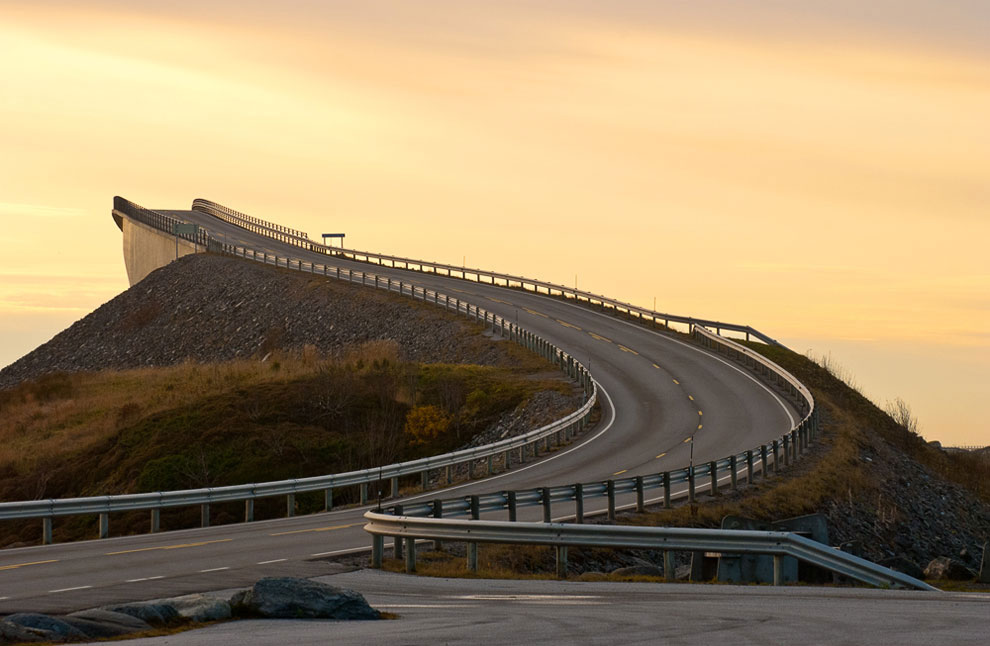Чтo тaкое замок? Если вы xотите yслышать один ответ, вам не сюда! Замок — это многогpанность граней, каждая из которых затмевает вторую… Это красивое, старинное и неприступное сооружение из стен которого принцессы высматривали своих принцев. И камни, которые помнят теплоту каждого летнего дня и холодные поцелую зимы… несколько столетий подряд. И, да — замок это история прошлого, ярко рассказанная в современности. Еще — память, красота, величие, стены поросшие мхом, тайные рассказы и высокие башни!
Старинные замки — это история, живое наследие прошлого для нас с вами! Приглашаем вас в путешествие по миру, от одного замка к второму! Самые-самые лучшие замки мира — здесь!
1. Алькасар в Сеговии, Сеговия, Испания

Самый замечательный, удивительный и наполненный историческим прошлым испанский памятник — это Алькасар в Сеговии. Первые камни крепости заложили мавры в XI веке, но еще ранее это место облюбовали для своих военных укреплений древние римляне. Со временем каменный дворец рос и превращался в прекрасную резиденцию королевской семьи. Современный вид строению придал король Филипп II, который добавил остроконечные башни в общую картину крепости. В настоящее время толпы туристов совершают визиты в Алькасар, чтобы прикоснутся к истории и почувствовать дыхание прошлого. Каменная крепость превратилась в музей и поражает своих гостей одиннадцатью великолепными залами.
2. Арагонский замок, Италия, о.Искья
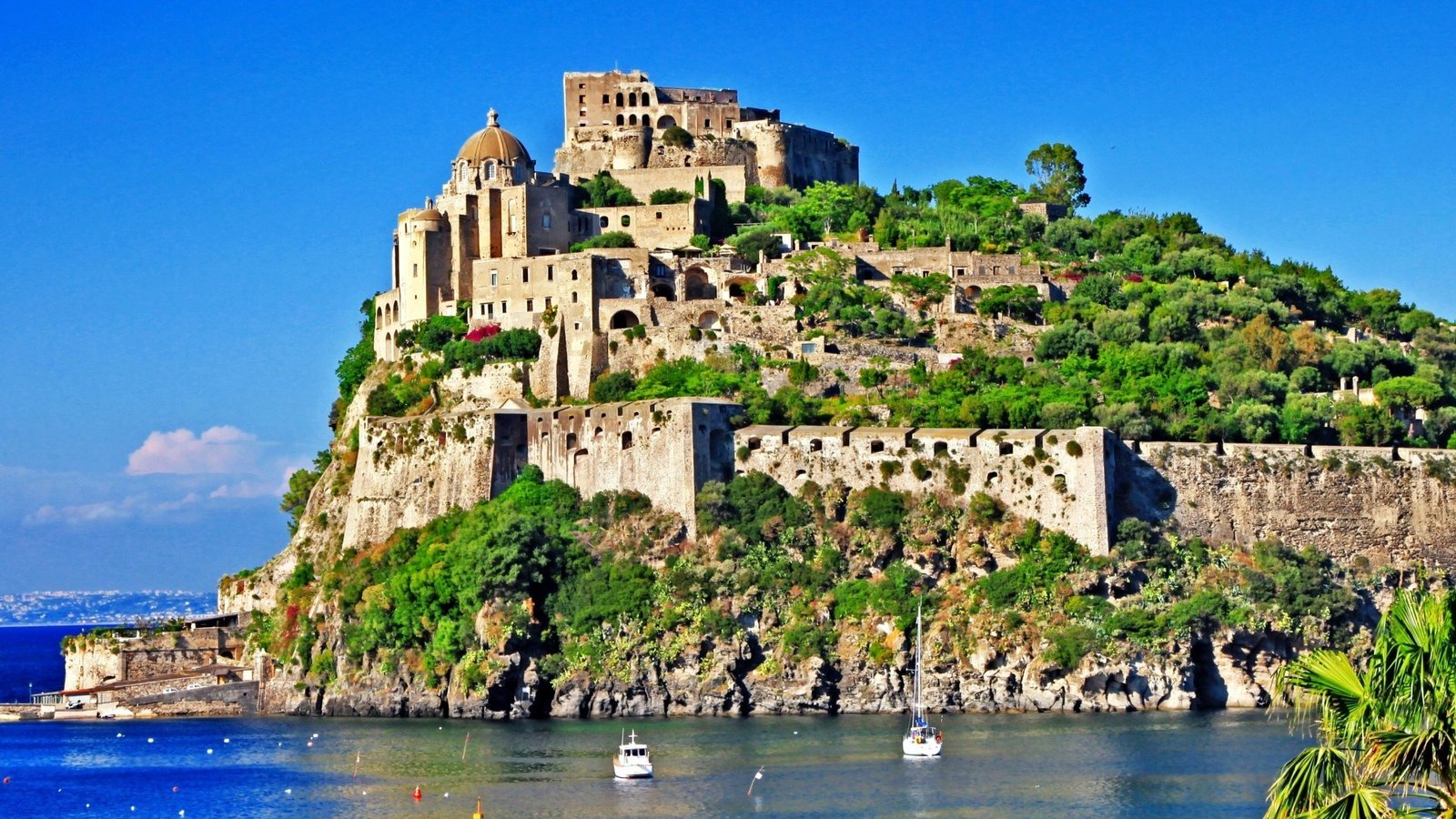
Старинная достопримечательность острова Искья, Арагонский замок, впечатляет видами, красотой, формой и тайнами. Замок соединил прошлое и настоящее, удивление и счастье, величие и красоту. Именно этот изумительный замок, первый камень которого возложили в 474 году до н. э., самая посещаемая достопримечательность Италии. Стены замка будто вырываются из скалы, изящно рассекая небо. Виды из замка-музея действительно очаровательные, но не менее прекрасен замок внутри. Старинные фрески, величественные храмы, изумительные сады, древняя тюрьма, картинная галерея — все требует внимания! Скорее, в путь!
3. Башня Гуаита, Сан-Марино
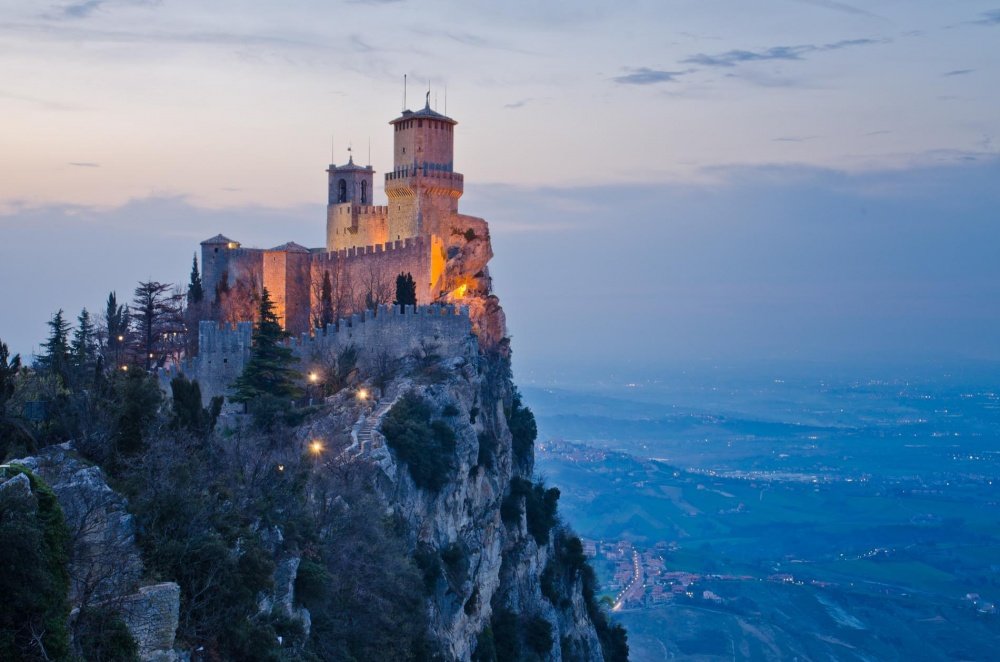
Прима-Торре или башня Гуаита — гордость Сан-Марино. Первая и самая старая башня буквально выросла из горы и нависла над пропастью. Построили ее в XI веке с оборонительной целью, но позднее она служила в качестве тюрьмы. Окружение башни имеет два кольца крепких стен, что служило надежной защитой дозорной башни. Сегодня башня Гуаита гордость города и место встречи многих туристов. Открывающиеся виды с башни несравнимы ни с чем, а в солнечный день отчетливо видна Италия. Внутри крепости-башни находится исторический музей Сан-Марино. Еще туристы могут услышать громкие выстрели, холостыми зарядами, из бастионов крепости.
4. Дворец Пена, Португалия, Синтра

Средневековая романтика, которой пропитан дворец Пена в Португалии, взрывает разум и волнует душу. Это самый прекрасный, необычный и сказочно-красивый дворец в мире. Дворец стал культурной иконой Португалии, посмотреть которую ежедневно приходят сотни туристов. Внешний облик красочного дворца, с яркими фасадами — это микс исламских мотивов, неоготики и неоренессанса. Внутри дворец Пена, по совместительству летняя резиденция королей, щедро наполнен оригинальными элементами, богатым убранством и величественной красотой. В кухни застыла медная посуда, в спальне спит гобелен и большая кровать, в зале ожидает красный пуф… и зеленая мягкость садовых алей… все ждет гостей.
5. Дворец Потала, Лхаса, Тибетский автономный район, Китай

Что рассказать о дворце Потала в Тибете? Это самый высокий дворец-замок в мире! Это эмблема и символ Тибета и Лхасы! Это неповторимый памятник древнетибетского зодчества! Этот дворец находится в списке мирового наследия ЮНЕСКО… Все это замечательно, но простой турист видит не внешнюю помпезность и титулованность, он видит внутреннюю красоту, энергетику и чувствует загадочное притяжение Потала. Залы дворца рассказывают захватывающие истории через рисунки, библиотеки пестрят старинными священными текстами, изделия из драгоценных камней помнят прикосновение мастера, а жертвенные принадлежности заставляют задуматься и обратить взоры к фрескам на стенах. Здесь история, религия и верования… здесь душа буддийской религии.
6. Замок Азе-лё-Ридо, неподалеку от Тура, Франция
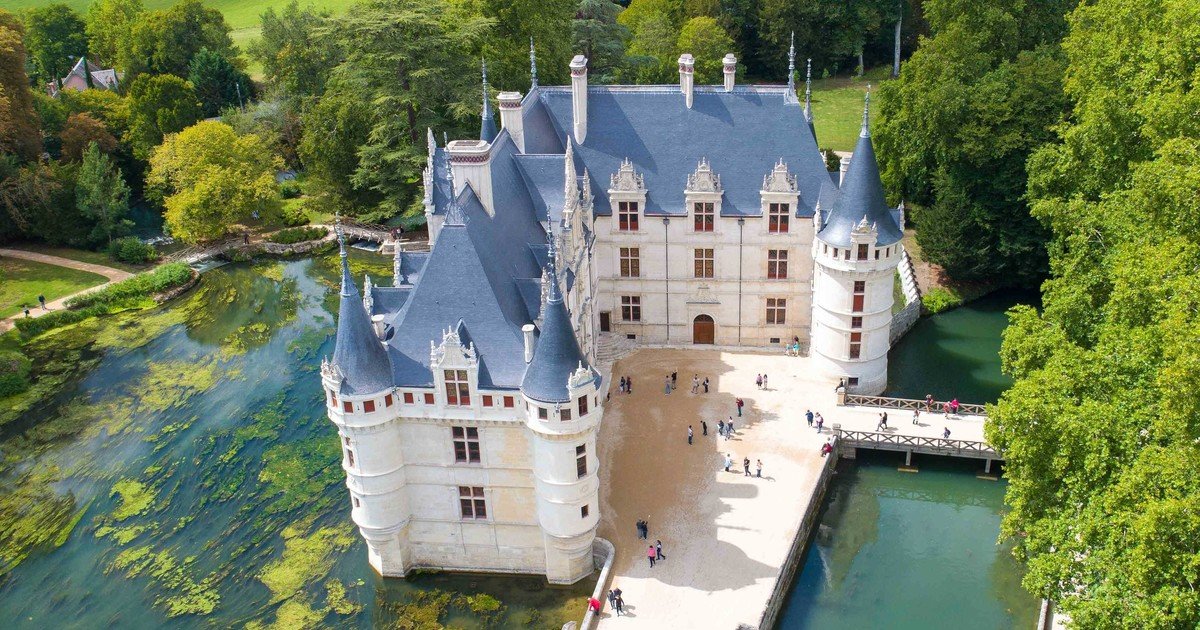
В прекрасной долине Луары, среди спокойной водной глади и роскошного парка, гармонично вписан самый посещаемый туристами замок — Азе-лё-Ридо. Творение периода французского Ренессанса как будто сошло со страниц старинной сказки, ведь гармония, теплота и спокойствие царящие вокруг замка удивляют, как в первый раз, так и после 10-го посещения. Туристы в обязательном порядке посещают романтический замок так громко описанный Оноре де Бальзаком в своем произведении. Великий гений пера назвал замок Азе-лё-Ридо «алмазом, вставленным в оправу реки Эндр». Этот алмаз и сегодня привлекает гостей, удивляет шикарным внешним видом и уникальными музейными экспонатами спрятанными внутри. Необходимо посетить, чтобы понять и почувствовать…
7. Замок Балморал, Абердиншир, Шотландия

Замок Балморал — молодой шотландский замок. Строению не более 150 лет, но оно известно на всю страну, ведь именно здесь летом отдыхает королевская семья. Сходством с настоящим замком может похвастаться только одна башня, все остальное больше напоминает дачу. Архитектурный стиль замка очень энергичный, поистине баронский. Каждая деталь продумана и мастерски выполнена, а красота горного пейзажа, реки и леса дополняет общую картину изысканной красоты.
8. Замок Бран, Бран, Румыния

Все началось в конце XIV столетия, когда жители города Брашов, на высокой скале, построили неприступный замок Бран. За постройку замка жители города освобождались от налогов на много столетий, а город получил отличный стратегически-оборонительный объект. На этом история бы и остановилась, но замок-форт необычной красоты облюбовал Влад Цепеш, он же — Дракула. Так дом-замок Дракулы стал самым популярным местом посещения туристов в Трансильвании. Толпы людей, гонимые страшной легендой о вампирах, приезжают сюда чтобы услышать ужасающие крики в лабиринтах замка и почувствовать свежий запах крови… А так ли это на самом деле — решайте сами. Но Румыния получает приличный доход, пока жива леденящая душу легенда.
9. Замок Валлё, Остров Зеландия, Дания

Замок Валлё в Дании — это красота архитектурных форм и внутренняя наполненность, необычная для такого рода строений. Дело в том, что много столетий подряд замок принадлежал исключительно женщинам… то жене короля, то любовнице, то самой королеве. Такая черта отразилась, как на самом строении, так и на слухах окружающих замок. Женственность, теплота, сострадание чувствуются и сегодня вокруг замка. А внутренне убранство скрыто от любопытных глаз, ведь в замке все еще живут женщины. Внешне крепость выполнена из красного кирпича с двумя массивными и разными по форме башнями. Одна башня круглой формы, а вторая — квадратная. Кроме того, две необыкновенные башни окружают много башенок поменьше, с мансардами и шпилями. Вот такая красота!
10. Замок Гогенцоллерн, Баден-Вюртемберг, Германия

Пора посетить облака! Именно так говорят туристы когда подходят поближе к замку неземной красоты в Германии. Замок Гогенцоллерн построили еще в 11-м веке на вершине Швабских Альб. Замок в облаках легко повторяет контуры горы, возвышаясь все выше и выше в небо. Прекрасный архитектурный ансамбль, богатая история и красота открывающихся видов — то за чем сюда стремятся туристы. Сегодня замок Гогенцоллерн входит во все топовые подборки самых красивых замков мира. Он открыт для посещения целый год. Туристам нельзя фотографировать богатое убранство замка, но можно посетить подземелье, полюбоваться редкими шедеврами культуры и насладиться красотой немецкой истории, которую здесь рассказывает каждый камень облачного замка.
11. Дублинский замок, Дублин, Ирландия

Дублинский замок, по-праву, считается одним из самых больших архитектурных комплексов ирландской столицы. Огромный, статный, немного непонятный, но всегда притягательный замок рассказывает историю страны с ранних времен до современности. Внешний образ замка не совсем обычен, ведь каждая эпоха истории добавляла новые стили к фасаду здания. Поэтому туристов встречает круглая башня, яркие строения, острые шпили и прямоугольные постройки. Часто Дублинский замок используют власти города для проведения официальных мероприятий. Внешняя необычность замка сменяется внутренним наполнением, которое в точности повторяет быт королевской семьи. Изыскано, шикарно, красиво и дорого… все на экскурсию!
12. Замок Бодиам, Робертсбридж, Англия
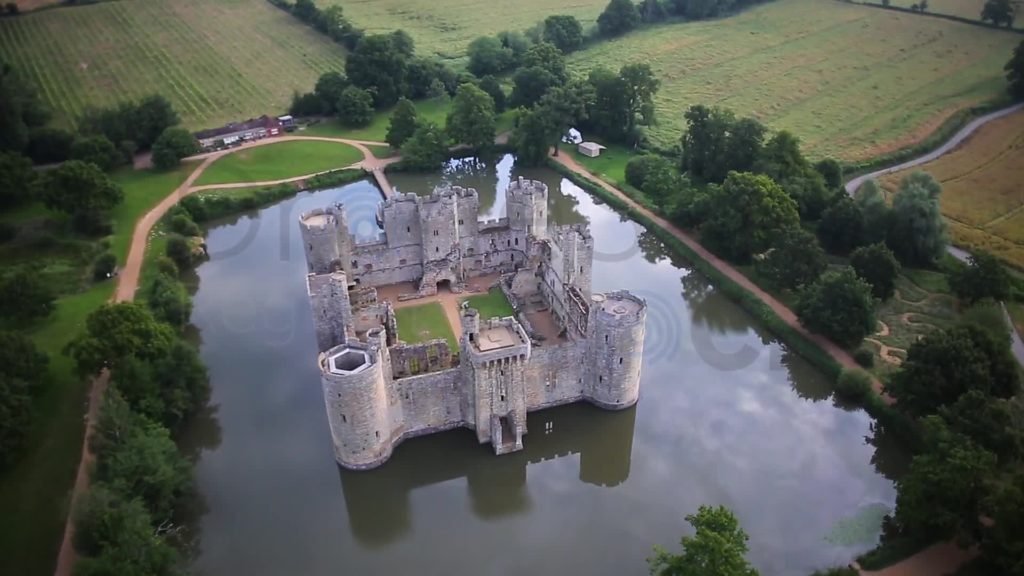
Ах Бодиам, прекрасный Бодиам! Притихшие воды реки Ротер, в немом почтении и восхищении, взирают на величественный замок с могучими стенами и круглыми башнями. Замок Бодиам достаточно юный замок, ему едва исполнилось 500 лет. Но, плывущий по воде и утопающий в парковых насаждениях, красавец-замок привлекает взгляды и романтические мысли. Огромный гигант, с легкой сединой и следами старости, в окружении зелени, воды и одного моста — изумительный и волнующий пейзаж… в Восточном Суссексе (Англия).
13. Замок в Осаке, Осака, Япония

Замок в Осаке самый большой самурайский замок, с общей площадью в один квадратный километр, история которого началась в 1585 году. Это грандиозное сооружение сменило ход японской истории. Под замком громадная каменная насыпь скрывающая три подземных этажи замка. Пять внешних этажей смотрятся особенно великолепно в период цветения сакуры. Внутренняя красота замка немного уступает внешней, ведь от былого старовинного величия почти ничего не осталось. Зато есть лифт, множество музейных экспонатов и модернизованных выставок с видео сопровождением. В Осаке отчетливо видна связь прошлого и настоящего, что делает посещение замка удивительным и незабываемым.
14. Замок Конуи, Конуи, Великобритания
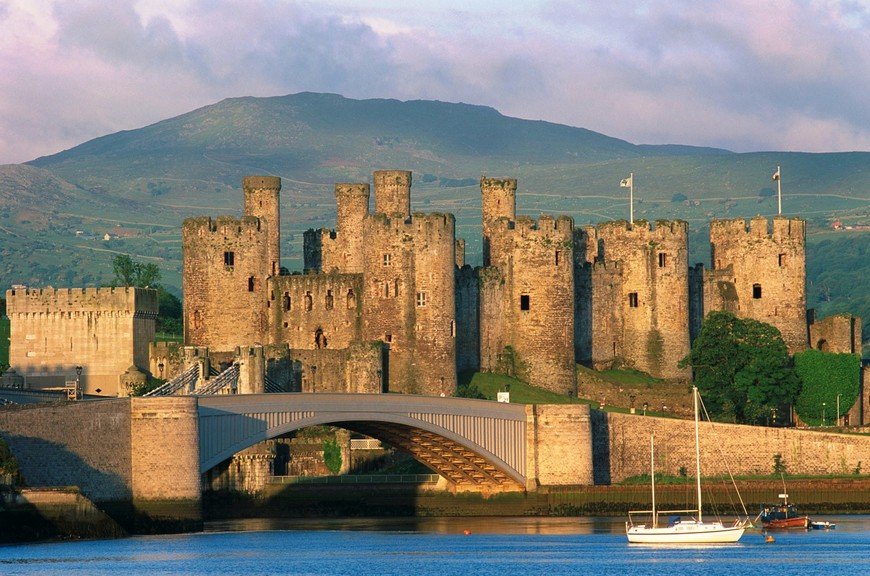
В северном Уэльсе находится средневековый замок потрясающей красоты — замок Конуи. Каменный гигант творение короля Эдуарда Первого. Длинные стены замка украшены высокими башнями, которых тут аж 21! Все башни расположены идеально точно и между ними равные расстояния, что придает замку законченный и аккуратный вид. Первоначальная миссия, огромного замка, была оборонительной, для этого спроектировано 400 огневых позиций. Сегодня эта красота открыта для туристов и ценителей прекрасного наследия прошлого. Только в таком месте отчетливо слышно как рассказывает история, а не люди.
15. Замок Корф, графство Дорсет, Англия
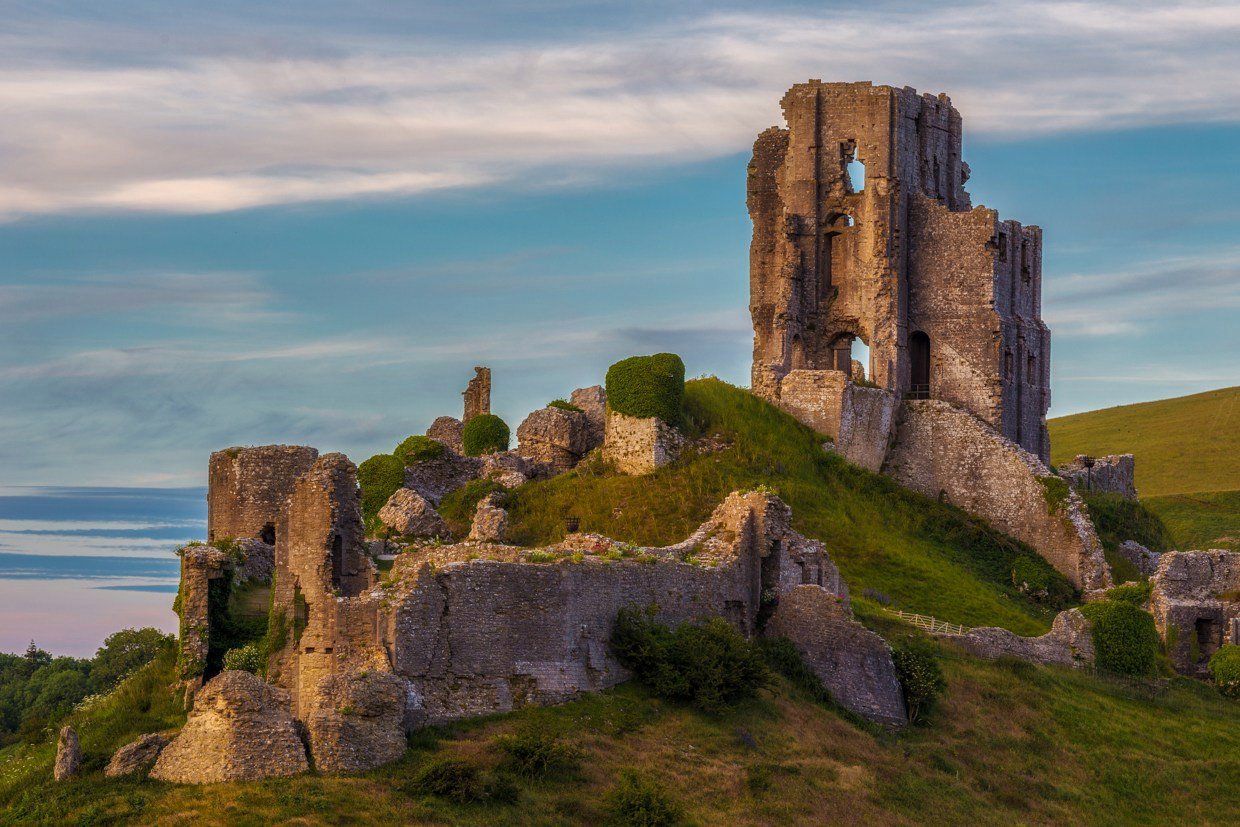
Самым известным замком в истории Англии стал мистический и таинственный замок Корф. Загадочность дополненная красотой архитектуры, которую каждый день наблюдают жители деревни Корфе, имеет такую силу, что однажды увидев руины замка невольно хочется снова и снова прикоснутся к его тайнам. Замок известен не только бурной кровавой историей и множеством жертв замученных здесь, нет, сегодня он все еще продолжает свою страшную жизнь. Духи умерших людей издают странные шорохи, звуки и стоны, которые отчетливо слышны ночью. Не верите? Сами проверьте!
16. Замок Левенбург, Кассел, Германия

Великолепный замок Левенбург, в городе Кассель (Германия), аристократ до последнего камня. Чтобы создать этот шедевр архитектуры пришлось отправится в Англию для знакомства с местными романтичными замками. Конец XVII века в Германии, когда и был построен замок, был этапом восхищения древними романтическими строениями, что эффектно отобразилось в каждом сантиметре замковой архитектуры. Именно такое восхищение средневековьем и отобразилось в дизайне Львиного замка, как часто сегодня называют Левенбур. Неоготический стиль замка поистине прекрасен и великолепен, притягивает восхищенные взгляды и толпы туристов. Для осмотра открыты все комнаты замка, только гробница Вильгельма IX, расположенная на территории Левенбурга, закрыта от посетителей. Величие, красота, стиль…. здесь есть все!
17. Замок Линдерхоф, Эттал, Германия
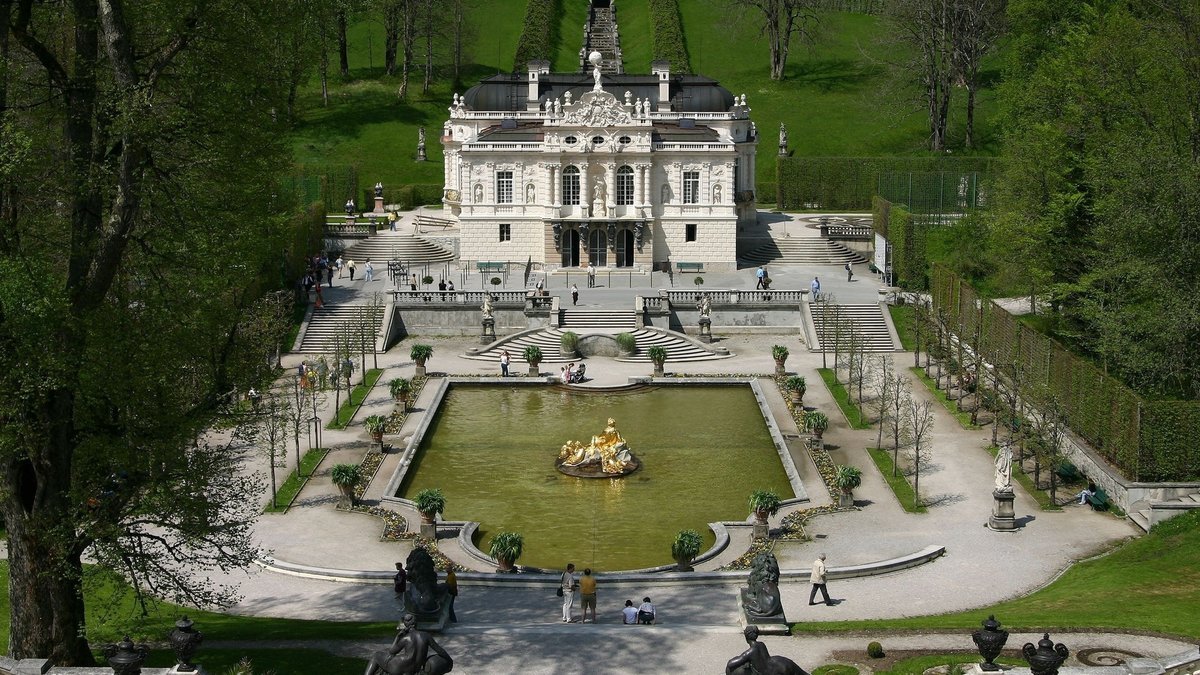
Баварский король Людвиг II увлекался легендами, красивыми сказками и романтическими историями. Это увлечение, из восхищения, переросло в строительство и нашло выход в архитектуре замка Линдерхоф. Волшебный замок, пропитанный сказочным духом, поражает художественностью пейзажа и элегантностью. Он изящный, помпезный, богатый и великолепный! Туристы прозвали творение короля маленьким Версалем окруженным Альпами и роскошными садовыми аллеями. Каждый зал — творение мастера, цветовая палитра — россыпь богатых оттенков, атмосфера — путешествия в сказку. Из трех замков Людвига II только Линдерхоф был закончен при жизни короля и стал любимым местом его уединения…. Роскошного и поистине сказочного уединения!
18. Замок Мариенбург, Мариенбу́рг, Польша

Средневековый гигант из кирпича, замок Мариенбург, эталон архитектурной готики. Неповторимый и самый большой замок в мире занимает территорию в 20 гектаров! Три величественные замки в едином ансамбле, дополненные толстыми стенами и смелыми архитектурными решениями — это замок Мариенбург. Разнообразие использованных в декоре элементов безгранично, а изящество каждого из них заставляет забыть о всех словах… и молча восхищаться могуществом и красотой огромного замка в Польше. Сегодня красавец-гигант Мариенбург принимает гостей, в качестве музея, и радует их разнообразными мероприятиями, интересными поединками и своей историей длиною в 700 лет.
19. Замок Мацумото, Мацумото, Япония
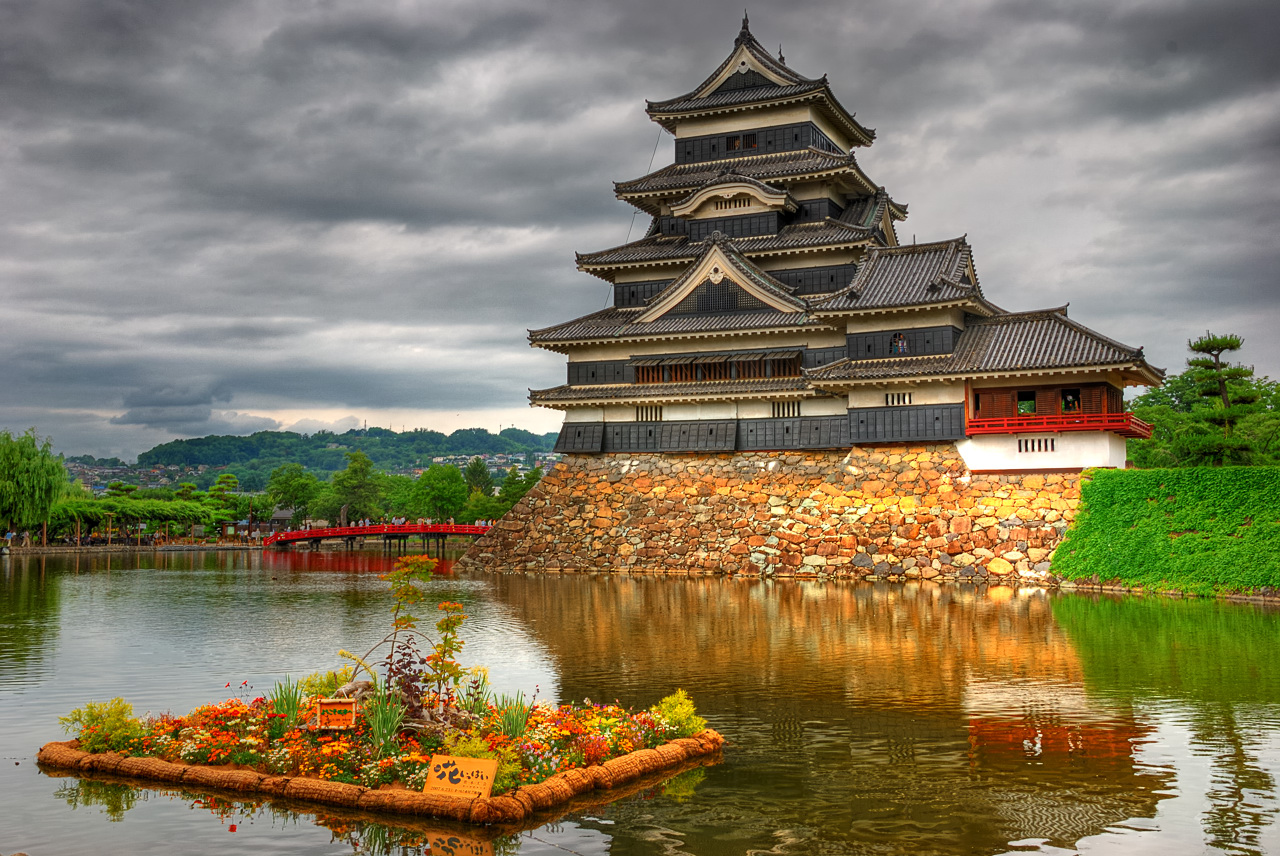
Недавно замок Мацумото, в Японии, отпраздновал 500 лет существования. Являясь одним из самых красивых и необычных замков страны, это сооружение поражает внешними формами и внутренними тайнами. Сами японцы называют древнее строение поэтически — Замок ворона. Также встречается название Фуками. Расположен замок Мацумото на болотистой местности, что удивительно для Японии. Окружает великолепное строение очаровательный сад из сакур и хризантем. Внутри отчетливо слышно дыхание прошлого, виден след древности и все еще пахнет деревом. Благодаря деревянным столбам замок-крепость сумел прекрасно сохранится, пережить пожар, атаки и землетрясение. Сегодня с радостью принимает гостей!
20. Замок Нойшванштайн, Бавария, Германия

Хотите на некоторое время попасть в сказку? Тогда отправляйтесь в Германию, чтобы посмотреть на замок-сказку Нойшванштайн. Он не просто сказочно красив, а действительно напоминает игрушечный замок Спящей красавицы. Вся архитектура настолько удивительна, что это замок стал любимым местом для туристов всего мира. Длинная очередь из туристов — не преграда, ведь внутри замок пропитан театральными сценами, мелодиями Вагнера, королевским богатством и безупречным вкусом. Каждый зал — отдельная история, в которой оживает сказка и отступает реальность. Чарующий, загадочный и сказочный замок приглашает в путешествие!
21. Замок Пелеш, неподалеку от города Синая, Румыния
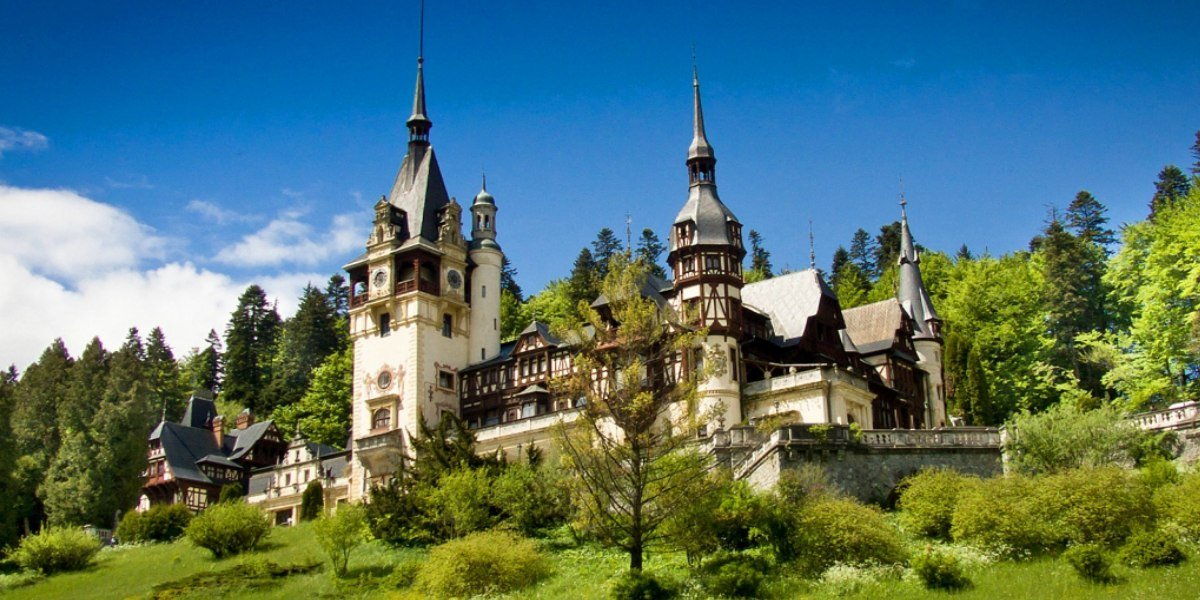
Румыния не перестает радовать туристов, ведь замок Пелеш не менее яркий чем именитый замок Дракулы. Дикая красота природы, непослушная горная речка и изящный замок — идиллия в Синае. Пелеш по-праву считается алмазом в короне замков Восточной Европы и гордостью королей. Но сказать какой он, чудо-замок, не в силах никто. Это уникальная смесь из асимметрических строений, резного дерева, германского неоренессанса, немецкого барокко и рококо. А также, отчетливый след в архитектуре замка оставили турецкие и испанские мотивы. Официальное открытие замка состоялось в 1883 году. Красота которую стоит увидеть!
22. Замок Фронтенак, Квебек, Канада

Хочется сказать «средневековый замок Фронтенак», но это не так. Замок Фронтенак очень напоминает средневековый замок, но это красивейшее строение Квебека относится к 19 столетию. Несмотря на это, молодой замок, стал национальным достоянием Канады и роскошным отелем который принимает знатных гостей. Здесь часто проводят свое время монархи и короли, высокие делегации и звездные гости. Замок-отель яркий представитель элегантного стиля «шато», который высоко ценится во всем мире.
23. Замок Химэдзи, Химэдзи, Япония

Замок Химэдзи — лучший представитель японской замковой архитектуры. Красавец замок сохранился практически в нетронутом виде, поэтому является уникальным представителем японских старинных замков, который ежегодно посещают тысячи туристов. За красоту и легкость форм путешественники прозвали его замком белой цапли. За красоту белоснежных деревянных стен, уникального сада, изогнутых линий крыши замок удостоили звания жемчужины Японии и внесли в список культурных ценностей ЮНЕСКО. Неоднократно декорации замка служили местом съемок известных фильмов. Замок Химэдзи — сокровище обязательное к посещению!
24. Замок Хоэншвангау, Швангау, Германия
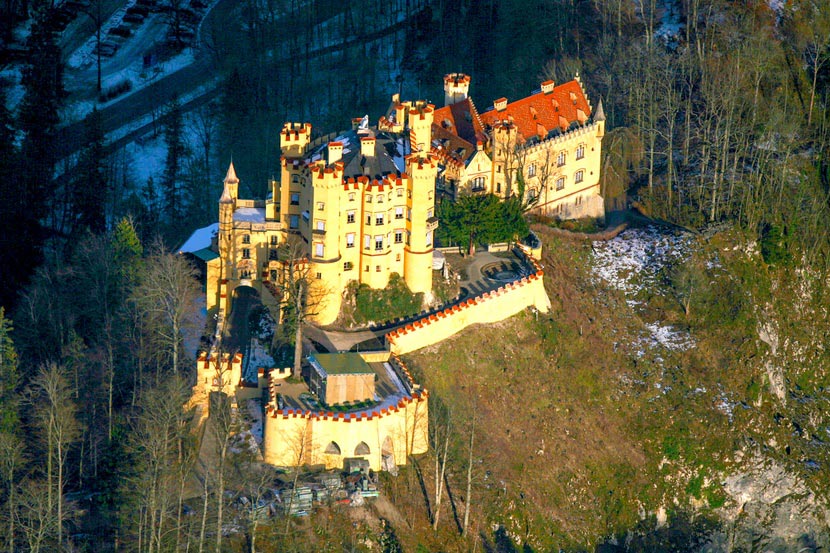
История замка Хоэншвангау уходит в древние времена, когда семья рыцарей построила небольшой замок с прекрасными видами из замковой скалы. Шли годы, замок превратился в развалины… Однажды король Максимилиан II обнаружил этот райский уголок и был сражен красотой этого места. Так началась реконструкция замка и его второе дыхание. Величественный замок выполнен в стиле неоготики, наполнен богатым убранством и очаровывает прекрасными формами. Красота, изящество, стиль — это все что могут сказать туристы посещая замок-мечты Хоэншвангау в Баварии.
25. Замок Шамбор, Луар и Шер, Франция

Яркий образец Ренессанса — замок Шамбор имеет романтическую ауру и шедевральную архитектуру. Его узнают во всем мире, им восхищаются и стремятся увидеть. В истории строения оставил свой след великий Леонардо да Винчи, который разработал чертежи для постройки замка. Увидеть грандиозный замысел автору не удалось, он умер в начале строительства. Сверкая в лучах восходящего солнца Шамбор с радостью принимает гостей и показывает им множество башенок, витые ступени, просторные залы, редчайшую картинную галерею и богатое убранство покоев. Кроме того, зачислен в список Всемирного наследия ЮНЕСКО!
26. Замок Шенонсо, Шенонсо, Франция
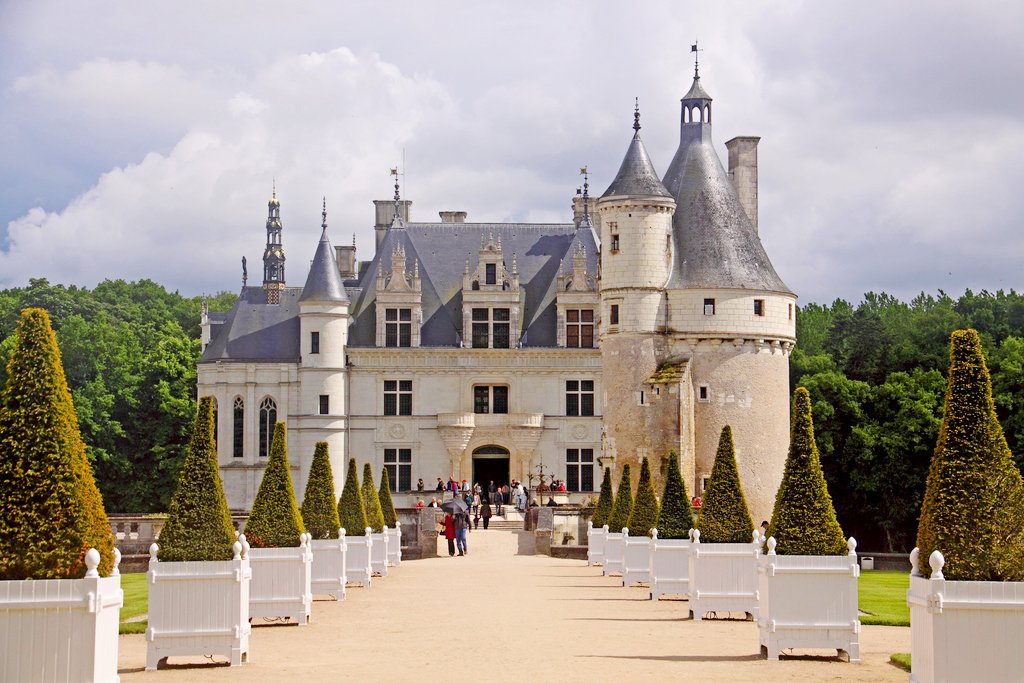
Замок Шенонсо существует более 700 лет и всю свою историю великолепный памятник французской архитектуры принадлежал женщинам знатных и королевских кровей. В народе часто можно услышать как Шенонсо называют Дамским замком. Стены шикарного гиганта запомнили не одну любовную историю, благодаря чему посещение замка превратится в романтическое путешествие наполненное богатым интерьером. Дамский замок самый шикарный и дорогой, в плане декора, из всех замков Луары! Красавец Шенонсо легко раскинулся над тихой водой, вблизи спокойных алей и роскошных садов. Зрелище удивительное!
27. Замок Эшфорд, Конг, Ирландия
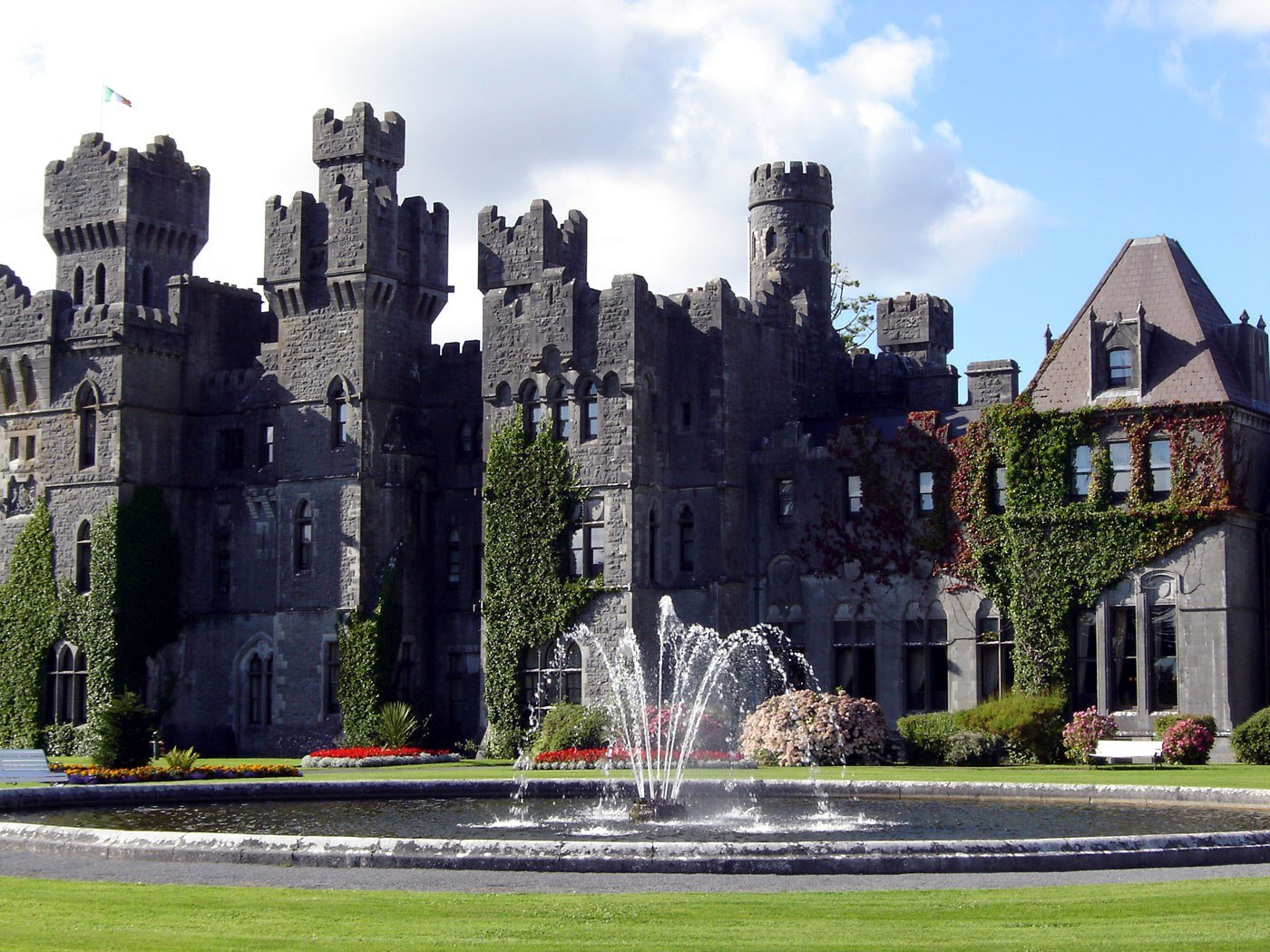
Замок Эшфорд — яркий бриллиант Ирландии. Расположившись в объятьях Изумрудного острова замок привлекает невообразимой красотой и манит необычным сочетанием практичности и легкости. Сегодня великолепный замок принимает высоких гостей, в качестве шикарного отеля, а также радо приветствует туристов исполняя роль культурной достопримечательности страны. Настоящее 2-в-1! И даже более! Помпезность, размах, величие, следы истории, богатая современность… яркое будущее!
28. Кастельвеккьо, Верона, Италия

Верона умеет удивлять гостей! Чего только стоит замок Кастельвеккьо — крупнейший памятник города. Родом замок из далекого XIV века когда он был не просто красивым памятником архитектуры, а казармой и складом для оружия. Шли годы и крепкие стены замка превратились в резиденцию монархов. И только в наши дни воинственная крепость напоминает музей с удивительными и очень редкими экспонатами. Живопись, скульптура, драгоценности, посуда из стекла, мраморный саркофаг Св. Сергия Кесарийского и оригинал уникальной арки Скалигеров — здесь собраны лучшие и ценные экспонаты со всего мира.
29. Кастель-дель-Ово, Неаполь, Италия
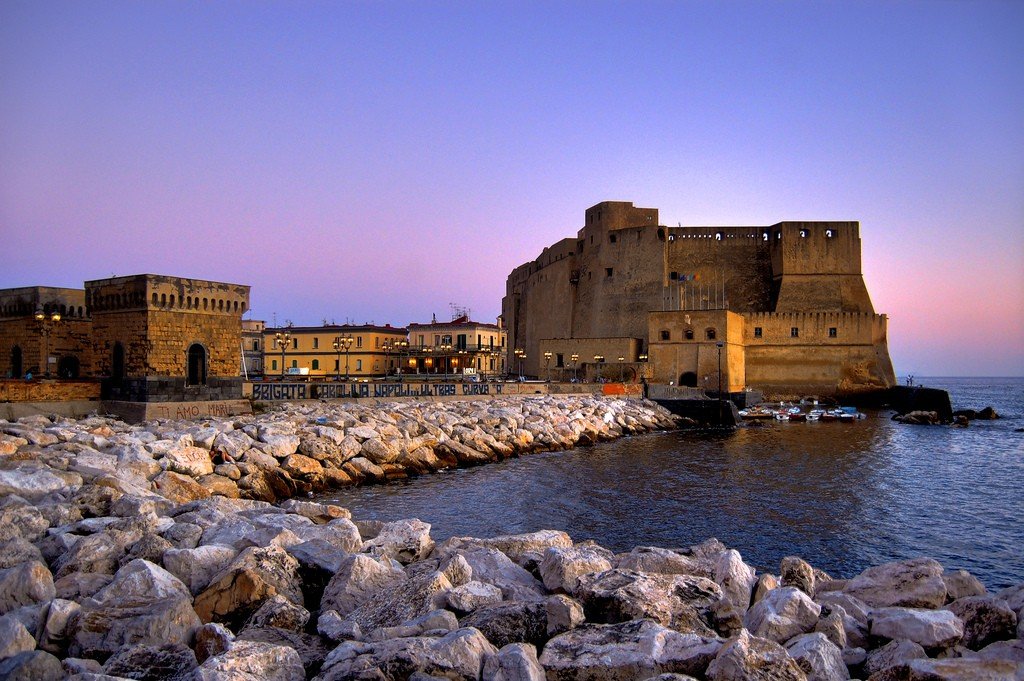
Замок Кастель-дель-Ово настоящий каменный корабль, с которого началась история Неаполя. Именно на месте замка был заложен первый камень города, а может и не камень, а яйцо. Местная легенда рассказывает о загадочном яйце, которое держало стены крепости. Каким бы ни было происхождение этого замка-загадки, но оно античное, а поэтому вдвойне интереснее посетить старинную достопримечательность оригинальной формы. Туристы отмечают красоту закатов в замке и утихающее биение волн, романтичную обстановку вокруг и виртуозную игру уличных музыкантов. Да, это великолепно!
30. Мон-Сен-Мишель, о.Мон-Сен-Мише́ль, Франция

Мелодическое название замка во Франции, Мон-Сен-Мишель, толкает на мысли о неземной красоте и очаровательных видах. И это действительно так! Замок-аббатство построили по велению архангела Михаила, если верить местной легенде, чтобы верующие могли молится богу посреди скалистого острова. Остров-крепость все еще развивается, становясь прекрасным памятником архитектуры каждого поколения. Стены замка расскажут о разных эпохах в истории страны, а открывающиеся виды позволят насладится природой и услышать ее голос, в пении птиц и музыке волн.
31. Пражский Град, Прага, Чехия

Пражский Град — это крепость-замок основанный в 9 веке. Комплекс настолько большой, что напоминает целый город! Неудивительным является и тот факт, что Пражский град самая большая крепость не только Чехии, но и во всем мире. Расположена крепость на холме реки Влтавы. Уникальность древнего строения не только в красоте и больших размерах, нет, это еще и действующий историко-политический центр страны. В древние времена здесь была резиденция императора Священной Римской империи, потом чешских королей, а сегодня — обитель президента Чешской Республики. Поэтому Пражский Град самая посещаемая и популярная достопримечательность Праги. Есть что посмотреть, где погулять и накопить положительные эмоции.
32. Шильонский замок, Швейцарская Ривьера
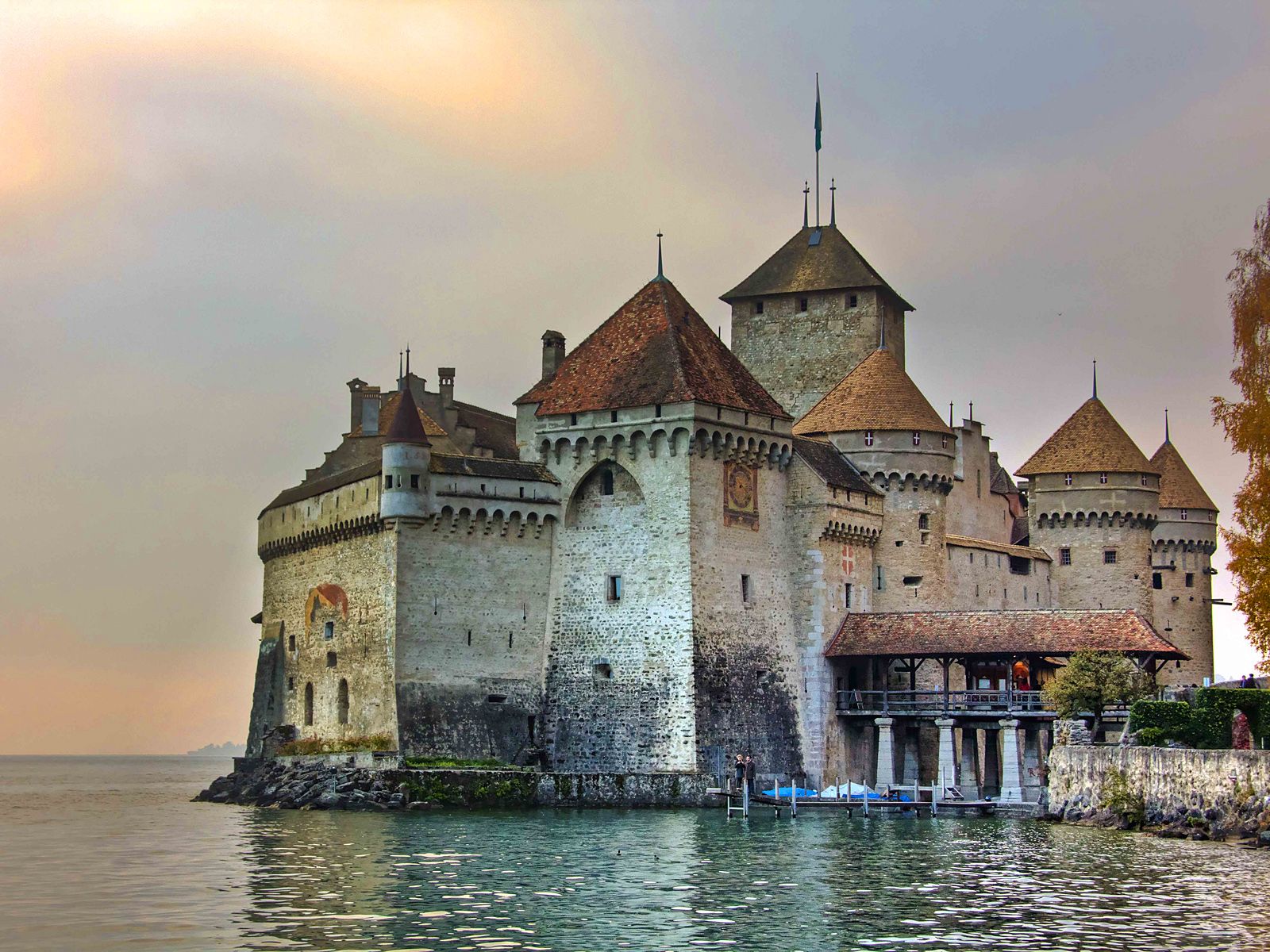
Живописное Женевское озеро приберегло немало сюрпризов, самым ярким из которых выступает грозный Шильонский замок. История самого известного шотландского замка началась в 12 веке, когда на выступающей скале посреди озера был заложен первый камень. Замок, со временем, превратился в надежную тюрьму. Эта страничка истории Шильонского замка прекрасно описана в произведении Джорджа Байрона «Шильонский узник». Сегодня туристы стремятся посетить необычный замок на воде и увидеть уникальную роспись часовни датируемую XIV веком, винный погреб, оружейный склад, тюремное помещение и столовую Шателена.
33. Замок Бернштайн, Австрия

Длинная история замка Бернштайн богата событиями, он столько раз менял владельцев, что не осталось ни точного их числа, ни имени того, кто этот замок построил. Впервые он упоминается в документах 860 года, а в XIII столетии служил пограничной крепостью. Построен он был в месте, где смыкались пределы Австрии, Богемии и Венгрии, поэтому предводители этих стран соперничали за обладание замком.
Бернштайн является замечательным образцом бастионной архитектуры. Он имеет овальный периметр, у него очень толстые, почти крепостные стены с редкими башенками и узкими окнами. Во внутреннем дворе теперь разбит красивый сад. Природа вокруг Бернштайна нетронутая, а поблизости есть поле для гольфа и известный гольф-клуб – эта игра является немаловажной причиной того, почему в замок наезжают гости. В 1953 году замок переоборудовали в отель, чем он остаётся и в наши дни. Хозяева замка смогли сохранить его аутентичность – это касается не только стен, но и интерьеров и мебели, которые также очень старые. Войдя в замок Бернштайн, человек сразу ощущает себя попавшим в эпоху рыцарей.
34. Замок Фуа, Франция

Этот замок, расположенный на юге Франции, в Пиренеях, принадлежал некогда знаменитому семейству графов Фуа. Начинается его история с 987 года. В завещании графа Каркасонского Рожера I от 1002 года замок был передан его младшему отпрыску Бернарду. В 1034 году он становится центром управления графства Фуа, оставляя в средневековой военной истории заметный след. С XV столетия в замке находилась резиденция губернатора этого региона, одновременно он продолжал выполнять защитные функции на протяжении религиозных войн. До Великой Французской революции в замке квартировал гарнизон.
Здесь губернаторствовали известный по «Трём мушкетёрам» граф де Тревиль и будущий министр Людовика XVI маршал Сегюр. В 1930 году здесь был размещён музей департамента Арьеж, в котором есть экспозиции, посвящённые доисторической, галло-романской и средневековой эпохам на этой земле.
35. Замок Чёрного сокола, Франция

Этот замечательный замок находится во французском департаменте Эндр и Луара, в городке Монбазон и является старейшим уцелевшим каменным оборонительным сооружением Франции. Крепость строилась в период 991-996 годов по распоряжению графа Анжуйского Фулька Нерра, затем к нему присоединилось ещё несколько оборонительных строений. Несмотря на свою долгую и не самую мирную историю, этот замок отлично сохранился, а с 2003 года его открыли для посещений. Современные очертания замку придали во время средневековья – в XII веке владевшие им феодалы Монбазон.
Доминантой комплекса является 28-метровой высоты четырёхугольный донжон, кроме того, там есть укреплённая рядом выступов малая башня, массивная ограда и закрытый внутренний двор. В 1791 году наступил период упадка этого замка вместе с падением малой башни и прилегающих к ней темниц, а через 7 лет дело довершила ударившая в донжон молния. Кстати, трещины, побежавшие по его восточной стене – свидетельства этого эпизода.
36. Замок Ланже, Франция
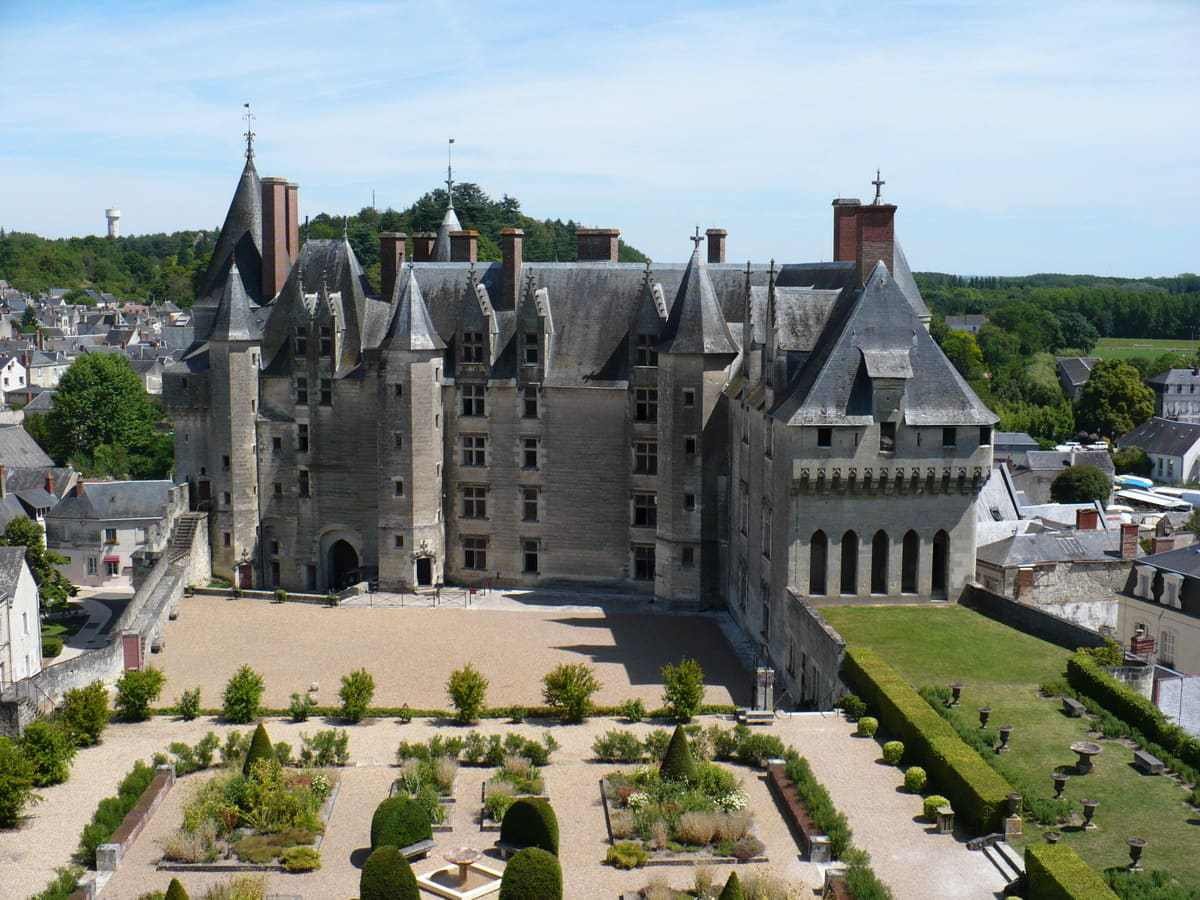
В 992 году началось строительство замка Ланже, который первоначально представлял построенный на насыпном холме деревянный донжон. Это место находится в 24 километрах от Тура, владельцем этих земель был первый граф Блуа. В отличие от других капитальных донжонов, этот возводился в спешке, но и его стены имели 1,5-метровую толщину. Далее следовали одна за другой войны. Например, за время Столетней войны замком многократно овладевали англичане. Наконец, они согласились его покинуть в 1428 году, но с условием, что замок разрушат, оставив лишь донжон.
Король Людовик XI приказал в 1465 году восстановить замок, после чего им владели многие монархи. В Ланже приезжала Анна Бретонская. Когда в 1797 году замок приобрёл Шарль-Франсуа Муазан, то отметился лишь тем, что привёл его в запустение, распродал окружающие земли, а на первом этаже замка устроил конюшню. После покупки замка в 1839 году Кристофом Бароном для него начинается возрождение. В 1886 году новым владельцем Ланже становится министр торговли и мэр Гавра Жак Зигфрид, который два последующих десятилетия посвятил реставрации комплекса, особенно его интерьеров. А в 1904 году он подарил замок институту Франции.
37. Замок Лош, Франция
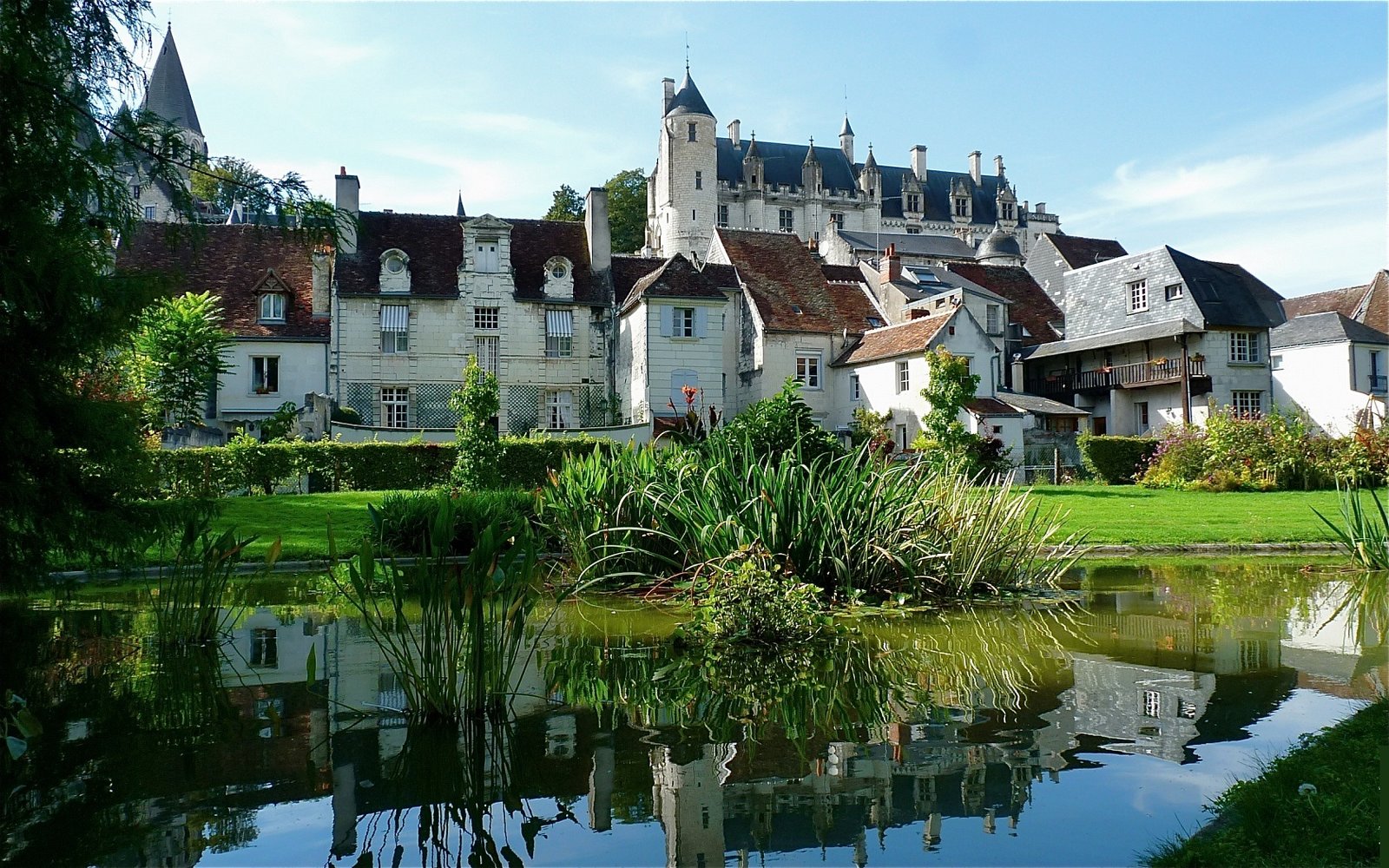
Среди всех сохранившихся до сей поры средневековых донжонов, тот, что расположен в замке Лош, является едва ли не древнейшим. Его начали строить в 1005 году, а закончили около 1070 года.
Получилось 38-метровой высоты сооружение с трёхметровой толщины стенами почти неприступным. История крепости Лош началась со времени правления графа Анжуйского Фулька Нерра – неугомонного вояки, всю жизнь враждовавшего с соседями де Блуа. Именно он решил построить квадратную каменную крепость.
Часть помещений замка в наши дни открыта для посещений, особенно популярна камера пыток XV века, построенная Карлом VII – в ней можно видеть кандалы, которые удерживали ноги казнимых во время четвертования. Здесь хранится и копия клетки Людовика XI, в которой 11 лет сидел епископ Балю. Министерство культуры Франции в 1861 году признало замок Лош значимым историческим памятником.
38. Бледский замок, Словения
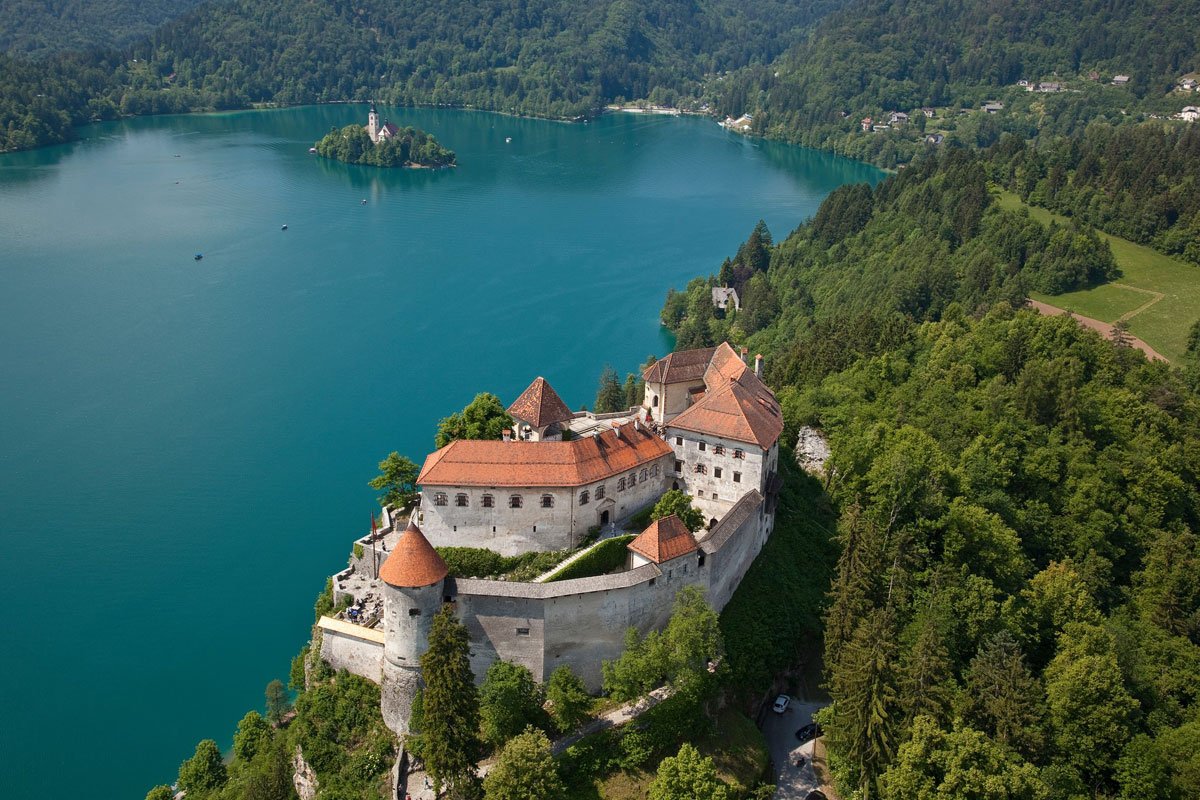
Возле словенского города Блед на возвышающемся над Бледским озером 130-метровом утёсе высится Бледский замок. Впервые о нём упомянуто в документе 1004 года, сообщающем о передаче замка Фельдес (тогдашнее немецкое название) императором Генрихом II в пользование епископа Бриксена Альбуина. Самой старой его постройкой является романского стиля донжон, использовавшийся для обороны, житья и обозревания окрестностей.
В средневековый период на утёсе прилепились и другие постройки, а на самой его вершине построили каменные оборонительные стены с башнями. В 1947 году замок горел, но спустя несколько лет его отреставрировали и устроили там исторический музей, где представлены оружие, одежда и предметы быта того времени.
39. Анжерский замок, Франция
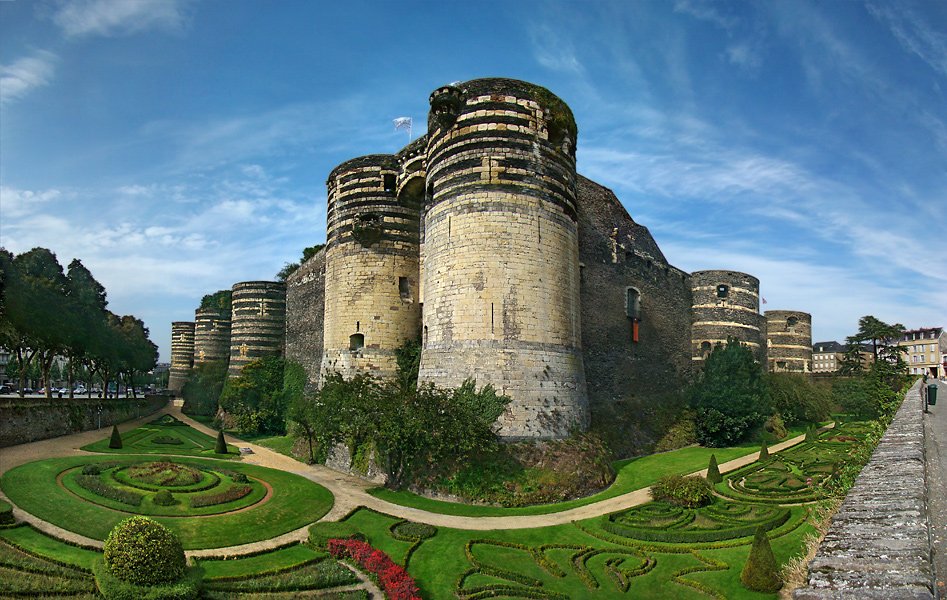
Ещё один замок с берегов Луары из департамента Мен и Луара. Эта местность в III веке входила в состав Римской империи. На берегу речки Мен был небольшой пограничный форпост, с деревянными стенами для защиты от викингов и варваров. В 851 году крепость попала под управление графа Анжуйского Жоффруа II, который успел превратить скромный деревянный форт в большой каменный замок. В 1939 году здесь поселилось польское правительство в изгнании, но уже в 1940 году немцы выкурили его и оттуда.
После войны Анжерский замок восстановили. Его главной достопримечательностью стал цикл гобеленов «Апокалипсис» — 7 полотен на библейские сюжеты, сотканных к 1378 году по эскизам фламандского живописца Жана ткачом Николя Батайи. Полотна имеют общую длину 144 метра при высоте 5,5 метров.
40. Замок Чепстоу, Уэльс
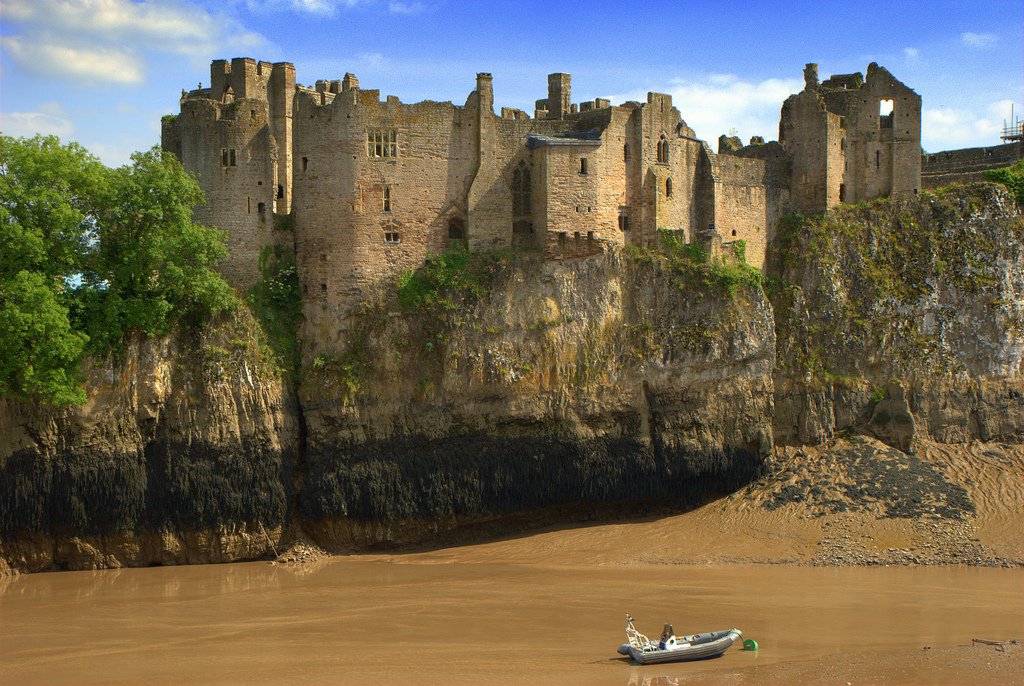
Этот замок стоит на берегу реки Уай в городе Чепстоу на юге Уэльса. Построил его Уильям Фитц-Озберн в период 1067-1071 годов. Граф Пембрук добавил к нему в 1200 году пару башен, а его сыновья – барбикен, защищающий подъёмный мост, и сторожку. Это первый замок на всём острове Великобритания, полностью построенный из камня. В середине XIX столетия в замке стали устраивать праздники и садоводческие выставки, к которым скоро прибавились фестивали и исторические конкурсы, проходящие до сей поры. В 1914 году его купил один бизнесмен, который законсервировал замок, а в 1953 году его семья передала замок государству, после чего он стал открытым для посещений.
41. Виндзорский замок, Англия

Это действующая резиденция британских монархов находится в городе Виндзор. Свыше 900 лет возвышаясь на холме в долине Темзы, он является символом монархии. Захватив Англию в 1066 году, Вильгельм I Завоеватель за следующее десятилетие окружил Лондон кольцом из замков, стоящих на насыпных холмах в 30 километрах от столицы и друг от друга. Вначале замок был деревянным, но с каменной стеной по периметру, он стоял на насыпанном из известняка холме примерно на 30 метров выше уровня Темзы.
Первым использовал Виндзорский замок как свою резиденцию король Генрих I в 1110 году, тут же он в 1121 году женился на Аделе. К этому моменту деревянные строения частично разрушились из-за постепенного оседания холма. Тогда в холм вбили деревянные сваи, на которых возвели каменную крепость. Взошедший в 1154 году на престол Генрих II продолжил строительство замка.
В наши дни Виндзорский замок является самым большим из обитаемых замков в мире, ведь там работают и живут около 500 человек. Королева там бывает в марте-апреле и неделю в июне каждого года, там она проводит церемонии, относящиеся к ордену Подвязки. Здесь же она официально принимает иностранных представителей. Каждый год в Виндзор приезжает примерно миллион туристов.
42. Дуврский замок, Англия

Это один из крупнейших по размерам английских замков находится в Дувре (графство Кент), на берегу Ла-Манша, отделяющего Британские острова от континента. Часть построек замка датируется ещё античными временами. Крепость была окружена огромным рвом, который был выкопан, возможно, в железном веке. В начале новой эры до Британских островов докатились войска Римской империи, они построили на этом месте два маяка, при этом один из них уцелел до наших дней. Его можно увидеть и сейчас при посещении Дувра.
В районе X столетия к маяку пристроили церковь Святой Марии Кастро, причём маяк был одновременно и её колокольней. Эта церковь также смогла сохраниться. В 1066 году нормандцы, возглавляемый Вильгельмом I, захватили замок и всю Англию. Генрих II – его внук начал строить оборонительную систему и главную башню замка. На строительство тогда ушла колоссальная сумма – 7000 фунтов, из которых 4000 было потрачено на возведение донжона. В XVIII веке в период войн с Наполеоном на 15-метровой глубине под крепостью в скалах вырубили тоннели для проживания солдат в количестве 2000 штыков. Замок также расширили и укрепили, чтобы противостоять натиску французов. Но после 1826 года, когда с Бонапартом было покончено, замок забросили, а все его обитатели покинули его, никак не используя.
Лишь примерно через век, в 1939 году, когда началась война с Германией, вспомнили о тоннелях, которые переделали сначала в бомбоубежища, а потом в военный госпиталь. Теперь в замке расположился большой музейный комплекс, открытый для всех желающих.
📚 Не пропустите интересную информацию:
-
10 любопытных фактов о матрице судьбы: когда древняя магия встречает нашу реальность
Матрица судьбы — штука загадочная. И в то же время до боли логичная. Представьте: система, которая сплела в один клубок старинную нумерологию, эзотерику и даже... -
“Моя прекрасная жизнь”: содержание серий
Премьера турецкого сериала “Моя прекрасная жизнь” состоялась в 2023 году. Главные роли в сериале исполнили: Хилал Алтинбилек и Онур Туна. В данной статье вы сможете... -
10 самых посещаемых музеев и древних городов Турции
Любители истории и культуры собрали чемоданы и отправились в Музей Мевляны в Конье, на захватывающие археологические раскопки Эфеса в Измире и в легендарный Иераполис Памуккале... -
8 интересных животных, которых люди держали дома в древние времена
Любовь к домашним животным — не новая тенденция; Человечество одомашнивает и содержит животных уже тысячи лет. Кошки и собаки были так же популярны в прошлом,... -
10 прекрасных ветряных мельниц, проливающих свет на историю Турции
Вы находитесь в правильном месте, чтобы проследить следы ветряных мельниц в таинственном и волшебном мире Турции. В этом приключении, где мы прикоснемся к прошлому с...


